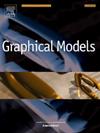Human perception faithful curve reconstruction based on persistent homology and principal curve
IF 2.2
4区 计算机科学
Q2 COMPUTER SCIENCE, SOFTWARE ENGINEERING
引用次数: 0
Abstract
Reconstructing curves that align with human visual perception from a noisy point cloud presents a significant challenge in the field of curve reconstruction. A specific problem involves reconstructing curves from a noisy point cloud sampled from multiple intersecting curves, ensuring that the reconstructed results align with the Gestalt principles and thus produce curves faithful to human perception. This task involves identifying all potential curves from a point cloud and reconstructing approximating curves, which is critical in applications such as trajectory reconstruction, path planning, and computer vision. In this study, we propose an automatic method that utilizes the topological understanding provided by persistent homology and the local principal curve method to separate and approximate the intersecting closed curves from point clouds, ultimately achieving successful human perception faithful curve reconstruction results using B-spline curves. This technique effectively addresses noisy data clouds and intersections, as demonstrated by experimental results.

基于持久同调和主曲线的人类感知忠实曲线重建
从噪声点云中重建符合人类视觉感知的曲线是曲线重建领域的一个重大挑战。一个具体的问题涉及从多个相交曲线采样的噪声点云重建曲线,确保重建结果符合格式塔原则,从而产生忠实于人类感知的曲线。该任务包括从点云中识别所有潜在曲线并重建近似曲线,这在轨迹重建、路径规划和计算机视觉等应用中至关重要。在本研究中,我们提出了一种自动方法,利用持久同调提供的拓扑理解和局部主曲线方法从点云中分离和近似相交的封闭曲线,最终获得成功的人类感知忠实的b样条曲线重建结果。实验结果表明,该技术有效地解决了噪声数据云和交叉的问题。
本文章由计算机程序翻译,如有差异,请以英文原文为准。
求助全文
约1分钟内获得全文
求助全文
来源期刊

Graphical Models
工程技术-计算机:软件工程
CiteScore
3.60
自引率
5.90%
发文量
15
审稿时长
47 days
期刊介绍:
Graphical Models is recognized internationally as a highly rated, top tier journal and is focused on the creation, geometric processing, animation, and visualization of graphical models and on their applications in engineering, science, culture, and entertainment. GMOD provides its readers with thoroughly reviewed and carefully selected papers that disseminate exciting innovations, that teach rigorous theoretical foundations, that propose robust and efficient solutions, or that describe ambitious systems or applications in a variety of topics.
We invite papers in five categories: research (contributions of novel theoretical or practical approaches or solutions), survey (opinionated views of the state-of-the-art and challenges in a specific topic), system (the architecture and implementation details of an innovative architecture for a complete system that supports model/animation design, acquisition, analysis, visualization?), application (description of a novel application of know techniques and evaluation of its impact), or lecture (an elegant and inspiring perspective on previously published results that clarifies them and teaches them in a new way).
GMOD offers its authors an accelerated review, feedback from experts in the field, immediate online publication of accepted papers, no restriction on color and length (when justified by the content) in the online version, and a broad promotion of published papers. A prestigious group of editors selected from among the premier international researchers in their fields oversees the review process.
 求助内容:
求助内容: 应助结果提醒方式:
应助结果提醒方式:


